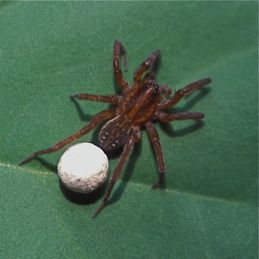Willis photographed this Common Iora (Aegithina tiphia) collecting spider silk for its nest (left). It can be a messy job as seen in the image but spider silk plays an important role in the makeup of small nests of many small birds. The silk helps bind up the nesting materials, making the nest a more sturdy structure.
An earlier post on the Black-naped Monarch (Hypothymis azurea) nest shows whitish spider cocoon silk on the nest surface together with mosses and liverworts.
Now, there is a difference between spider silk and spider cocoon silk. Spider silk comes from the web proper (below left). It is commonly believed that the sticky silk helps bind the superficial nesting materials together, just like in a sticky tape. However, according to Hansell (2007), only some spiders coat their webs with sticky droplets to trap prey, but these soon dry out. So the sticky tape idea is out.
It appears that the silk is used according to the Velcro principal. The silk provides the Velcro “loops” and the tiny leaves of the mosses and liverworts the “hooks”.
Another interesting point is that most of the silk that are seen on nests come from spider cocoon silk, the silk that is used to enclose the spider eggs (above right). Thus we see masses of white rather than single strands of white silk.
Image of iora collecting silk by willis; those of spiders by YC.
References:
1. Hansell, Mike (2000). Bird nests and construction behaviour. Cambridge University Press.
2. Hansell, Mike (2007). Built by animals. Oxford University Press.
This post is a cooperative effort between www.naturepixels.org and BESG to bring the study of bird behaviour through photography to a wider audience.












2 Responses